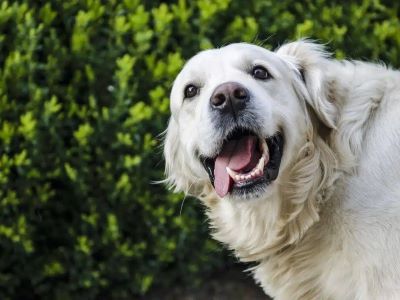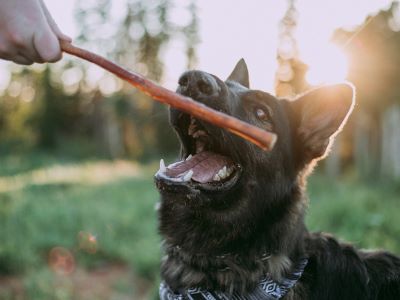You are cuddling with your dog, and they decide to give you a big, wet kiss. But instead of a nice kiss, you get a not-so-nice smell that makes you move away. That smell comes from your dog’s mouth, and it happens when their teeth aren’t clean.🐶

So, you might be asking yourself “How to clean dog teeth without brushing?“🦷 Well, we have got your back. We’ll learn some tricks to keep your dog’s teeth fresh without the tricky brushing part. Get ready to learn how to clean your dog’s teeth without making them look silly trying to use a toothbrush!
How to Clean Dog Teeth Without Brushing?
Cleaning your dog’s teeth is essential for their overall health and well-being, but not every pup enjoys a toothbrushing session. Fortunately, there are alternative ways to maintain their dental hygiene[1]. Let’s see them in detail:
1. Chew Toys and Dental Chews
Chew toys🧸 and dental chews help to remove plaque and tartar buildup by mechanically scrubbing your dog’s teeth as they chew. Chewing encourages saliva production, which aids in cleaning and protecting the gums. Here are some types of dental chews available:
- Rawhide Chews: These are traditional options, but be cautious with them as they can be hard to digest and may cause digestive issues in some dogs.
- Dental Bones: Specifically designed for dental care, they are softer than rawhide and gentler on the digestive system.🦴
- Rubber Dental Toys: These toys have textured surfaces that aid in cleaning teeth and massaging gums.
- Edible Dental Chews: These are treats that serve a dual purpose by being tasty and effective at teeth cleaning.
Ensure that the chew toy or dental chew is an appropriate size for your dog to prevent choking hazards. Choose high-quality and vet-approved dental chews to ensure they are safe and effective.

Be careful, as they can be calorie-dense. Check the chew toy or dental chew regularly for signs of wear and tear, and replace it if it becomes damaged to avoid choking risks.
Have you ever thought about how many teeth your dog has? If this is the case, check our article on “how many teeth do dogs have?” more information.
2. Dental Sprays and Water Additives
Dental Sprays and Water Additives are easy-to-use solutions for maintaining your dog’s oral hygiene.
Dental sprays, available in liquid or spray form, break down plaque, reduce bacteria, and freshen breath. Water additives, mixed with your dog’s drinking water, continuously coat teeth and gums to combat dental issues.🦷❌
Consult your vet before use, follow instructions closely, and use them consistently. While these products offer convenience, they should complement, not replace, regular vet check-ups and professional cleanings.🏥
3. Dental Diets and Treats
Dental diets and treats are specially formulated dog foods and snacks designed to promote oral health.
Dental diets and treats often contain specific ingredients beneficial for dental health, such as:
- Abrasive Texture: Cellulose or calcium carbonate create a scrubbing effect on teeth.
- Enzymes: Some products contain enzymes that break down plaque and tartar.
- Antibacterial Agents: These ingredients help reduce harmful bacteria🦠 in the mouth.
- Natural Breath Fresheners: Some treats include parsley or mint for fresher breath.
Some dental diets are designed to replace your dog’s regular meals. If you choose this option, make sure it provides complete and balanced nutrition. Dental diets and treats work best when combined with other dental care methods like regular check-ups and professional cleanings.

4. Dental Wipes
Dental wipes are a convenient alternative to brushing for your dog’s oral hygiene. Designed specifically for dogs, these wipes help remove plaque and bacteria from their teeth and gums.🦷
To use them effectively, start by familiarising your dog with the wipes, allowing them to sniff and lick to ease into the process. Gently lift their lips to access teeth and gums, and rub the surfaces with the wipes, offering treats🍭 and praise👏 for cooperation.
While dental wipes are convenient and portable, they may not be as thorough as brushing and may face resistance from some dogs. Regular use and supervision are essential.👀
5. Gels and Foams
Dental gels and foams, the superheroes of toothy hygiene, come to the rescue when brushing just isn’t your dog’s cup of tea.☕
- Applying dental gels and foams is as easy as pie. Gently rub the gel or foam onto their teeth and gums. Think of it as a special massage for their mouth.👄
- Remember, the key is to use these products as directed. Don’t go overboard; a little goes a long way. And make sure your dog doesn’t swallow it all – we’re cleaning teeth, not creating bubble blowers!
Look for products with superhero🦹 ingredients like enzymes, antibacterials, and plaque-fighting magic.✨
6. Dental Rinses
Dental rinses for dogs are like a refreshing mouthwash, designed to promote oral hygiene without the fuss of brushing. Generally, you’ll pour the rinse into your dog’s water bowl or a separate container.
Make sure your dog drinks from the treated water💧 or container regularly. Dental rinses come in various options, from liquid solutions to powder additives for water. Some popular types are:
- Antibacterial Rinses: These target harmful bacteria in your dog’s mouth, reducing the risk of dental problems.
- Plaque and Tartar Control Rinses: These help prevent the buildup of plaque and tartar on teeth.
- Breath Freshening Rinses: Designed to combat bad breath, these rinses leave your dog’s breath smelling better.
- Natural Herbal Rinses: Some products use natural ingredients like herbs to promote oral health.
The rinse mixes with their saliva and gets to work, even reaching tricky spots in their mouth.

While these methods can help clean your dog’s teeth without brushing, using the best ultrasonic dog toothbrush regularly is still the most effective way to clean their teeth.
Natural Dental Care Options
Raw bones, such as beef or chicken bones, can serve as a natural toothbrush for dogs. Chewing on these bones helps scrape away plaque and tartar.🦷
Coconut oil🥥 contains antibacterial and antifungal properties, making it a natural option for promoting oral health. Simply apply a small amount to your dog’s gums and teeth[2].
“Apple slices,🍎🔪 when given in moderation, can help clean teeth naturally due to their fibrous texture. They also offer vitamins and nutrients“, says experts at Purina.
While natural options have benefits, they come with caution. Raw bones should always be supervised, and only appropriate-sized bones should be given to prevent choking or fractures.
Be mindful of allergies, not all dogs can tolerate coconut🥥 oil or specific fruits.
Regular Vet Check-ups
Regular dental check-ups with a vet are essential for early detection of dental issues. Vets can perform thorough oral exams, and X-rays, and identify potential problems that might go unnoticed at home. This helps prevent dental disease and associated health problems.🦴
The frequency may vary based on your dog’s age, breed, and overall oral health. Your vet will recommend the ideal frequency for dental check-ups and cleanings, typically ranging from once a year to every few years.💧
FAQ
❓How Can I Clean My Dog’s Teeth Naturally?
Before you doubt how to clean dogs’ teeth with healthy fruits and veggies, hear us out! Crisp fruits and raw vegetables, such as apples, carrots, and celery, aid in the removal of plaque from teeth and freshen breath.
❓Is It OK to Not Brush My Dog’s Teeth?
working up to brushing daily is ideal. But if their mouth is healthy, even three days a week can make a difference. Without brushing, plaque can build up, putting your dog at risk for bad breath, gum disease, and tooth decay.
❓Can I Use Saltwater to Clean My Dog’s Teeth?
Instead of toothpaste, use plain warm water, a very diluted saltwater solution or one of the excellent tooth cleansers now available for dogs and cats. Most tartar formation occurs on the outer surfaces of the teeth; so give those areas a good scrubbing. If your pet is cooperative, then try for the inner surfaces.
Conclusion
And that’s how it’s a wrap, we have covered, “How to clean dog teeth without brushing?” and now you don’t have to wrestle with your dog to clean their teeth, as there are other alternatives too.
Whether it’s the chew toys that spark joy in your dog’s heart or the dental rinses that dance in their water bowl, regular dental care is no joke.
While alternatives help, learning how to brush dog teeth is still an important part of regular dental care.
It’s the secret to fresher breath, brighter smiles, and a healthier, happier dog!
Reference:
- Arford, K. (2022). 5 Easy Ways to Keep Your Dog’s Teeth Clean. American Kennel Club.
- Woolley, J., Gibbons, T., Patel, K. B., & Sacco, R. (2020). The effect of oil pulling with coconut oil to improve dental hygiene and oral health- NIH.



